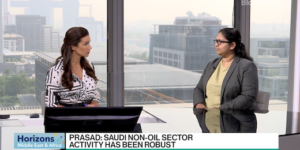The interview was published in the Mar/ Apr 2018 issue of the Bonds & Loans magazine; it is also posted online and can be accessed directly here.
US and EU monetary policy normalisation, the price of oil, and the pace of economic transformation are top of mind for many following the GCC, but the key risks – and opportunities – present in the region are both deeper and wider than is often appreciated.
Bonds & Loans speaks with the Nasser Saidi, former Minister of Economy and Industry for Lebanon and former Chief Economist and Head of External Relations at the DIFC Authority – and a keynote speaker at Bonds, Loans & Sukuk Middle East in Dubai later this month – about the top 5 themes likely to dominate the region’s economies this year.
What are the top 5 themes or risks likely to dominate GCC markets in 2018?
There are a number of global factors that are influential in shaping the GCC macro environment – and the most dominant of which is, of course, oil prices, and the trajectory of energy prices in general. GCC countries are all responding to the new oil norm – structurally lower oil prices in the long term, due to a combination of interrelated factors, and moderately lower or stagnant pricing in the near term.
The macro environment will be key. It’s not just the oil prices that influences external exposure – it’s also the financial markets. The GCC countries – particularly the UAE, Saudi Arabi and Qatar are all net capital exporters. And the size of those exports is substantial. Which means that whatever happens in global financial markets will have a significant impact on these countries’ ability to generate income.
Monetary policy normalisation is a growing risk. When the United States raises interest rates we do expect the entire yield curve to shift up, but the speed at which that happens is widely debated and largely depends on the extent to which GCC central banks mirror the move. They may need to depreciate their currencies in order to adjust to the tightening, but this obviously runs counter to their interest.
The development of more vibrant capital markets is also an important theme likely to dominate the region. We have seen significant growth last year in the scale of sovereign borrowing both in international markets through Eurobonds and local markets, in both conventional and Islamic formats. And if we look at growth of sovereign borrowing, the outlook is significant.
One factor that could have an impact on markets is the greater militarisation of the GCC countries’ foreign policy. There is growing confrontation between Saudi Arabia and Iran, playing itself out across the region. This is already disrupting trade flows and migration and could end up figuring back into the region’s markets in ways that aren’t entirely clear. It’s a risk factor people aren’t talking about nearly enough.
Are we seeing further stratification of the GCC on the fiscal side? Where are the bright spots, and what countries are you most concerned about?
Fiscal policy will be a key focus. Over the past few years, these governments have tended towards countercyclical fiscal policy: when oil prices are high, they increase spending, and when oil prices are down, the cut spending, which is largely how the oil shock transmitted itself to the non-oil sector. Governments have adjusted their budgets to account for the new oil price reality, and they have raised new taxes and reduced subsidies to maximise revenue.
They have also worked very hard to diversify their economies through export diversification and industrial development. This means greater privatisation, especially in energy, aviation, education and healthcare, and public-private partnerships. The potential for dramatic structural changes here are substantial.
With growing youth unemployment there is a risk that some of these initiatives are not showing signs of progress quick enough. This is a major issue in Saudi Arabia and Oman, and to a lesser extent in countries like the UAE, and if you look at some of the countries in North Africa, could be a tail risk if the environment doesn’t improve. The growing participation of women in the labour force is also crucial if these economies are going to make substantial gains in the right direction.
All of these changes are not easy to implement. It’s one thing to announce the plan at the top, but whether you have the agencies of change within the bureaucracies is quite another.
We are looking at deficits of between UDS160bn to USD180bn collectively up to 2020, and that’s at current oil prices. The 5% VAT is a small addition of revenue. If you look at the UAE for instance, the tax will generate anywhere between 1% to 1.5% of GDP. This obviously pales in comparison to the scale of the deficits we are seeing. Only Saudi Arabia and the UAE have introduced the VAT, which leaves something to be desired.
The outlook, however, differs in the region. It will be easier for a country as large and rich as Saudi Arabia to adjust to these challenges than for the UAE, but the scale of their deficits also differs significantly; the countries are likely to run deficits of about 7.5% and 2.5%, respectively.
It’s important to point out that while ambition is high on the economic restructuring front, most of the initiatives in all countries are still at the level of design – most importantly, delivery is light at the level of the private sector, where job creation is needed. Unfortunately, this is the case in all GCC countries.
The social and economic forces playing out in the region look to be creating a very toxic cocktail, but many analysts seem to view this as a problem reserved only for the Middle Eastern countries in North Africa and the Levant – and often exclude the GCC. To what extent do you see the GCC at risk of the same forces playing out across the wider region, particularly since the Arab spring?
It’s a good point. Throughout the entire region – including the GCC and especially Saudi Arabia, the largest of the group – you have very fast-growing young populations and high birth rates. In a country like Egypt, for instance, you have about 700,000 young people being added to the job market each year, but limited job creation taking place. About one in every three Egyptian youth is unemployed, which has created a good deal of anger and uncertainty. Most lawmakers realise this, but few admit it publicly, which is why there is such limited public discourse on policy solutions.
When I – indeed when most – think of this landscape, I think of the three ‘Ts’: Transformation, Transition, and Turbulence. All of the region’s countries need to liberalise and be much more open in order to bolster their economies. This is especially true of the region’s trade policy.
How central is trade reform to the broader process of economic liberalisation you alluded to earlier?
Further international trade integration is key. But like many others they also face the conspicuous fact that the world economic order has changed. Today’s main trading partners are no longer the US and Europe – they are countries like India and China. The need to have a greater overture to these countries is becoming more urgent, not the least of which because they are becoming significant investors in the GCC, both in terms of financial and human capital. GCC countries have a tremendous opportunity to capitalise on growing demand for regionally dominant commodities like oil, in the short term, and use additional demand for skills and services from the East to help further diversify their economies.
With the Saudi Aramco partial IPO on the horizon and other privatisations in the offing, 2018 certainly seems to be shaping up to become a lynchpin year for the region’s economies. But there have also been a number of delays, prompting some to question progress on reforms there
A key question lingering in the region is whether Saudi Arabia is going to join the ranks of other emerging markets in the MSCI benchmark. The Saudi government has certainly taken all the steps, in terms of the reforms required, to be admitted as an emerging market; as a policy advisor, I certainly wouldn’t want to risk an IPO without securing Emerging Market status because at the end of the day, you need institutional investors. If it’s going to happen, it needs to take place before June. It’s going to be crucial if the government is to attract additional private sector capital into infrastructure projects and public-private partnerships across a range of sectors, and an upgrade from Frontier to Emerging Market status would be a huge vote of confidence. If that doesn’t happen, they may have to delay the Aramco privatisation – and potentially other privatisation efforts, which would exacerbate the social, political and economic pressures of the day.






